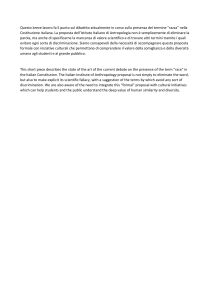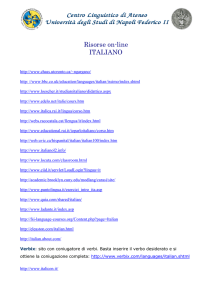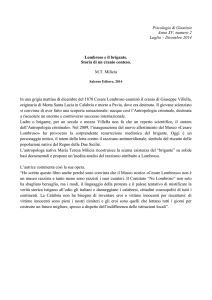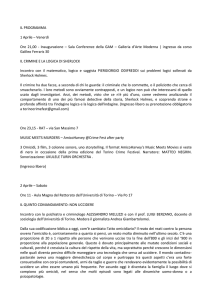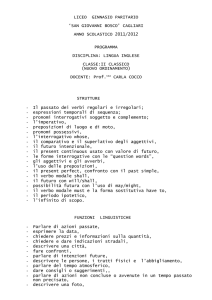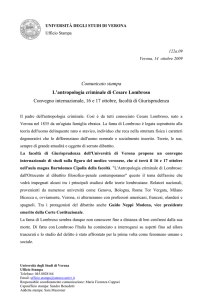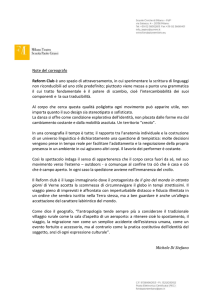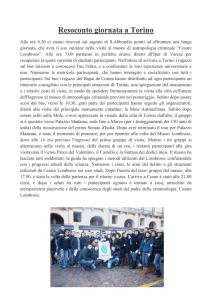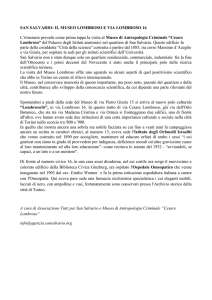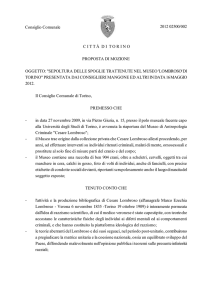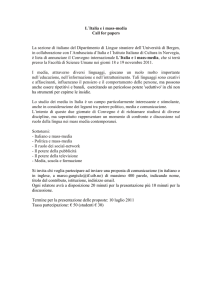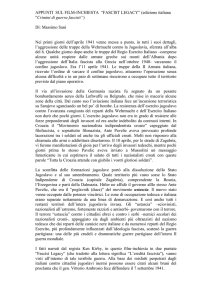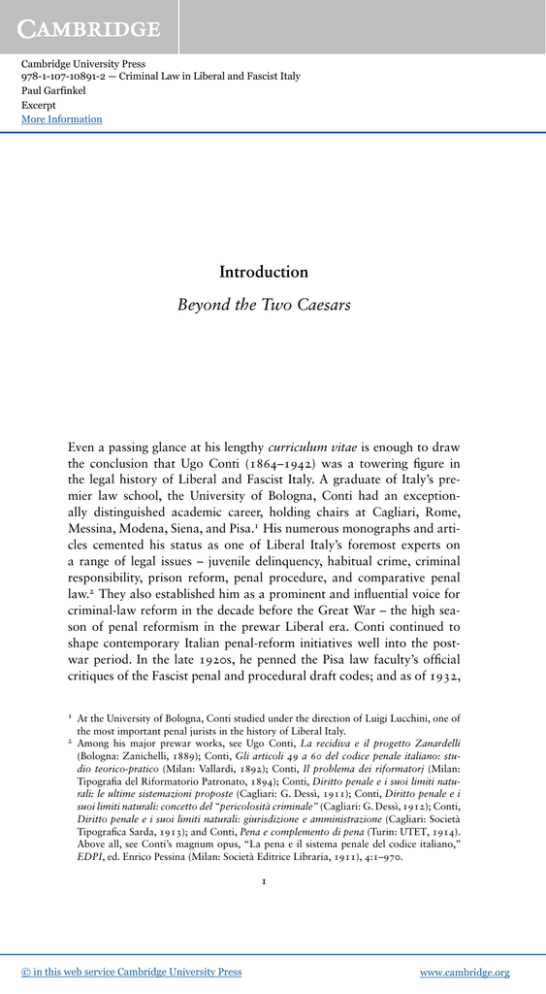
Cambridge University Press
978-1-107-10891-2 — Criminal Law in Liberal and Fascist Italy
Paul Garfinkel
Excerpt
More Information
Introduction
Beyond the Two Caesars
Even a passing glance at his lengthy curriculum vitae is enough to draw
the conclusion that Ugo Conti (1864–1942) was a towering igure in
the legal history of Liberal and Fascist Italy. A graduate of Italy’s premier law school, the University of Bologna, Conti had an exceptionally distinguished academic career, holding chairs at Cagliari, Rome,
Messina, Modena, Siena, and Pisa.1 His numerous monographs and articles cemented his status as one of Liberal Italy’s foremost experts on
a range of legal issues – juvenile delinquency, habitual crime, criminal
responsibility, prison reform, penal procedure, and comparative penal
law.2 They also established him as a prominent and inluential voice for
criminal-law reform in the decade before the Great War – the high season of penal reformism in the prewar Liberal era. Conti continued to
shape contemporary Italian penal-reform initiatives well into the postwar period. In the late 1920s, he penned the Pisa law faculty’s oficial
critiques of the Fascist penal and procedural draft codes; and as of 1932,
1
2
At the University of Bologna, Conti studied under the direction of Luigi Lucchini, one of
the most important penal jurists in the history of Liberal Italy.
Among his major prewar works, see Ugo Conti, La recidiva e il progetto Zanardelli
(Bologna: Zanichelli, 1889); Conti, Gli articoli 49 a 60 del codice penale italiano: studio teorico-pratico (Milan: Vallardi, 1892); Conti, Il problema dei riformatorj (Milan:
Tipograia del Riformatorio Patronato, 1894); Conti, Diritto penale e i suoi limiti naturali: le ultime sistemazioni proposte (Cagliari: G. Dessì, 1911); Conti, Diritto penale e i
suoi limiti naturali: concetto del “pericolosità criminale” (Cagliari: G. Dessì, 1912); Conti,
Diritto penale e i suoi limiti naturali: giurisdizione e amministrazione (Cagliari: Società
Tipograica Sarda, 1913); and Conti, Pena e complemento di pena (Turin: UTET, 1914).
Above all, see Conti’s magnum opus, “La pena e il sistema penale del codice italiano,”
EDPI, ed. Enrico Pessina (Milan: Società Editrice Libraria, 1911), 4:1–970.
1
© in this web service Cambridge University Press
www.cambridge.org
Cambridge University Press
978-1-107-10891-2 — Criminal Law in Liberal and Fascist Italy
Paul Garfinkel
Excerpt
More Information
Introduction
2
he edited two multi-volume treatises on Fascist criminal statutes of 1930.3
In addition to his proliic and inluential writing, Conti served on numerous national commissions for both the Liberal and Fascist governments
and assumed a high-proile role in child-welfare organizations and conferences. He was also prominent in the international penal-reform movement. For more than a quarter century, he was a member of Italy’s delegation to the International Prison Congress (IPC), the largest, oldest, and
most distinguished penal-reform body worldwide; after the First World
War, he also joined a pair of League of Nations committees on prisons
and the protection of women and children. So prominent and respected
was he that in 1927, the government of Colombia invited him to draft its
country’s criminal code.4
What makes Conti still more important is the era in which he lived.
The period from national uniication in 1861 to the Fascist dictatorship
(1922–1943) represents a critical and transformative one in modern Italian legal history. Soon after the Kingdom of Italy was born, an Italian (and
liberal) juridical culture emerged from the regional and variegated legal
orders of the several autocracies that had previously ruled the peninsula
and islands. By the Great War, a complex body of penal laws, institutions,
and reform initiatives had taken shape, including Italy’s irst national
criminal code in 1889; two codes of penal procedure (1865 and 1913);
national prison regulations in 1891; two sets of public-security (or police)
statutes (1865 and 1889); and numerous special acts, institutions, and
proposals that targeted violent, habitual, juvenile, alcoholic, insane, and
still other socially “dangerous” offenders. After Mussolini’s March on
Rome in 1922, Italian criminal justice underwent yet another transformation. In 1930, the dictatorship decreed the so-called Rocco Code, the
world’s irst “fascist” penal law. It also attempted to remake penal justice more generally by instituting a new code of penal procedure (1930),
rewritten public-security and prison regulations (both in 1931), and a
3
4
See Ugo Conti, Sul progetto preliminare di un nuovo codice penale (Bern: Stæmpli &
Cie, 1928); and Conti, Sul progetto preliminare di un nuovo codice di procedura penale
italiano (Bern: Stæmpli & Cie, 1930); Conti, ed., Il codice penale: illustrato articolo per
articolo, 3 vols. (Milan: Società Editrice Libraria, 1934–36); and Conti, ed., Il codice di
procedura penale: illustrato articolo per articolo, 3 vols. (Milan: Società Editrice Libraria,
1937).
See Guglielmo Sabatini, “Ugo Conti,” in Scritti in onore del prof. Ugo Conti per il trentesimo anno di ordinariato, 1902–1932 (Città del Castello: Unione Arti Graiche, 1932),
15–22.
© in this web service Cambridge University Press
www.cambridge.org
Cambridge University Press
978-1-107-10891-2 — Criminal Law in Liberal and Fascist Italy
Paul Garfinkel
Excerpt
More Information
Introduction
3
juvenile-justice system (1934). In short, Conti’s long career spanned a signiicant era in modern Italian legal history – and one Conti himself helped
to deine and to shape.
Yet, in existing scholarship on Italian legal history, the prominence,
inluence, and historical signiicance of Ugo Conti is consistently and conspicuously absent. The reasons for this omission become clear once we
consider how Conti’s views relate to scholarly interpretations of legal
culture and penal reform. Legal historians have traditionally characterized criminal-law reform in Liberal and Fascist Italy as an unceasing, bitter, and increasingly radicalized struggle between two rival penal schools
that began in the last quarter of the nineteenth century. On one side
was the traditionally dominant “classical school” of jurisprudence, which
espoused the liberal-Enlightenment penology that Cesare Beccaria had
articulated in his Of Crimes and Punishments (1764): moral fault as the
basis of culpability; retribution, repression, and proportionality as the
bases of punishment; the crime not the criminal as the object of that punishment; and the safeguarding of individual liberty as a primary function of penal law, among other things.5 On the other side was the upstart
“school” of positivist criminology founded by Veronese surgeon Cesare
Lombroso upon his publication of L’uomo delinquente (Criminal Man)
in 1876.6 According to this account, the juridical supremacy of the “classical school” was challenged by positivists’ new “scientiic” theories on
biological causes of crime; on social dangerousness as the basis for legal
responsibility; on prevention, individualization, and indeterminacy as the
aims of punishment; on the criminal himself as the object of punishment;
and on “social defense” as the purpose of penal law. Over time, this challenge was allegedly successful: not only did positivists come to dominate
the Liberal legal order, scholars contend, but they ultimately triumphed
5
6
Cesare Beccaria, An Essay on Crimes and Punishments, trans. and ed. Adolph Caso
(Boston: International Pocket Library, 1983).
Cesare Lombroso, L’uomo delinquente studiato in rapporto all’antropologia, alla medicina legale ed alle discipline carcerarie (Milan: Hoepli, 1876). For a recent reprint in Italian, see Lombroso, L’uomo delinquente studiato in rapporto all’antropologia, alla medicina legale ed alle discipline carcerarie, ed. Lucia Rodler (Bologna: Il Mulino, 2011). The
signiicantly expanded ifth and inal edition of Criminal Man has also been recently
reprinted. See Lombroso, L’uomo delinquente: quinta edizione, 1897, ed. Armando Torno
(Milan: Bompiani, 2013). For an overview of the ive editions of Lombroso’s magnum
opus between 1876 and 1897, see Lombroso, Criminal Man, trans. and with a new
introduction by Mary Gibson and Nicole Hahn Rafter (Durham: Duke University Press,
2006).
© in this web service Cambridge University Press
www.cambridge.org
Cambridge University Press
978-1-107-10891-2 — Criminal Law in Liberal and Fascist Italy
Paul Garfinkel
Excerpt
More Information
Introduction
4
over the classical school by fundamentally shaping the Fascist (or Rocco)
penal code of 1930.7
There is no place for Ugo Conti in this narrative. Rather than adhering
to one of these sharply polarized penal “schools,” Conti straddled them.
His “traditional” views of guilt and punishment appeared to it with the
so-called classical school. On the other hand, his concepts of social defense
and criminal dangerousness, as well as his signature idea of complementi
di pena (penal complements, or indeinite“security measures”against dangerous common offenders), seemed to embrace the penology of the rival
positivist school.8 In the context of the conventional narrative, then, Conti
represents an impossible hybrid of opposing penal philosophies, and his
inluence a clear and rare exception to the rule of positivist ascendancy.
The case of Ugo Conti illustrates both why this book was written and
what it seeks to accomplish. The fact that a man of such stature, authority, and inluence has been relegated to a historiographical no man’s land
raises signiicant questions about the adequacy and accuracy of current
narratives of this pivotal period in Italian criminal-law reform. Conti’s
7
8
This conventional narrative began in the early 1880s with positivist lawyer-criminologist
Enrico Ferri, who invented the idea of a “classical school” of jurisprudence as a straw man
against which he could position the so-called positivist school (scuola positiva). During the
Liberal and Fascist eras, many legal scholars – positivist or otherwise – adopted the general contours of Ferri’s framework when composing their own histories of Italian penal
law. For the Liberal period, see, for example, Silvio Longhi, Repressione e prevenzione
nel diritto penale attuale (Milan: Società Editrice Libraria, 1911). For the Fascist ventennio, see, among many others, Ugo Spirito, Storia del diritto penale italiano: da Beccaria
ai nostri giorni, 3rd ed. (Florence: G. C. Sansoni, 1974). This edition follows up those
previously published in 1925 and 1932. After the Second World War, the two-schools
narrative continued to dominate legal commentaries, which have generally seen the 1930
Rocco Code as a “compromise” between, or a “synthesis” of, classical and positivist penal
thought. This interpretation has been particularly evident in the scores of penal-law manuals and treatises published over the last several decades. Among countless examples, see
Bruno Cassinelli, Prospetto storico del diritto penale (Milan: dall’Oglio, 1954), 147–60.
Not limited to such works, however, the traditional account of Liberal and Fascist penal
law has generally been furthered by historians of the law and criminology. Among recent
examples, see Carlo Federico Grosso, “Le grande correnti del pensiero penalistico italiano tra Ottocento e Novecento,” in Storia d’Italia, Annali 12, La criminalità, ed. Luciano
Violante (Turin: Einaudi, 1997), 7–34; Luigi Ferrajoli, “Scienze giuridiche,” in La cultura
italiana del Novecento, ed. Corrado Stajano (Rome: Laterza, 1996), 559–97; Guido Neppi
Modona and Marco Pelissero, “La politica criminale durante il fascismo,” in Violante,
Storia d’Italia, Annali 12, La criminalità, 759–847, especially 813; Sergio Vinciguerra,
Diritto penale italiano, Vol. 1, 2nd ed. (Padua: CEDAM, 2009), 243–75; Mary Gibson,
Born to Crime: Cesare Lombroso and the Origins of Biological Criminology (Westport,
CT: Praeger, 2002); and Tiago Pires Marques, Crime and the Fascist State, 1850–1940
(London: Pickering & Chatto, 2013).
Ugo Conti, I complementi di pena (Milan: Vallardi, 1910).
© in this web service Cambridge University Press
www.cambridge.org
Cambridge University Press
978-1-107-10891-2 — Criminal Law in Liberal and Fascist Italy
Paul Garfinkel
Excerpt
More Information
Introduction
5
very existence implies that, at least to some degree, penal reform developed beyond the two Caesars of Cesare Beccaria and Cesare Lombroso
and their respective “schools.” Just how signiicant those developments
were is what this book will go on to reveal.
The interpretation it puts forward is the result of a broad and ambitious analysis of the evolution of criminal-law reform and legal culture
from the Liberal to the Fascist era. That investigation has been guided
by four central questions: (1) What precipitated the sustained and wideranging interest in penal-law reform from Italian uniication to the Great
War?; (2) What was the nature of Liberal-era reformism, and what can
it tell us about the ideological makeup and dynamics of Italian legal
culture throughout the prewar period?; (3) To what extent were these
penal-reform strategies speciic to Italy?; and (4) Why did these Liberalera reform initiatives largely endure after Mussolini’s March on Rome in
1922?
In both its scope and its approach, this book breaks new and important ground. It represents, for one, the most comprehensive account to
date – and the irst in a monographic study – of Liberal and Fascist penallaw reform and legal culture. Scholarly works on Liberal-era criminal-law
reform have before now focused overwhelmingly on positivist criminology and its (pseudo-)scientiic and extreme theories of inborn criminality and social defense. Accordingly, they begin their investigations only
with the publication of Cesare Lombroso’s Criminal Man in 1876, the
founding text of the positivist criminological movement; and they pay
only meager attention to the “classical” jurists who did not subscribe to
Lombrosian doctrine. By assessing Italian legal debates about crime and
criminality over a longer period, and by examining a broader range of
jurists, this study offers a richer and fuller understanding of the issues
that absorbed Italian penal reformers for decades. It also redresses a signiicant historiographical imbalance by centering extensively on common
rather than political crime. To date, legal historians of Italy (and of Fascist
Italy in particular) have focused their attention primarily on political
crime – despite the fact that from uniication to fascism, Italian penalists were concerned irst and foremost with common crime.9 Finally, this
9
On political crime in Liberal Italy, see, in addition to those cited in Chapter 3, Mario
Sbriccoli, “Dissenso politico e diritto penale in Italia tra otto e novecento,” QF 2 (1973):
607–702; Ferdinando Cordova, Democrazia e repressione nell’Italia di ine secolo (Rome:
Bulzoni, 1983); Floriana Colao, Il delitto politico tra Ottocento e Novecento: da delitto
ittizio a nemico dello Stato (Milan: Giuffrè, 1986); and Patrick Anthony Cavaliere, Il
diritto penale politico in Italia dallo Stato liberale allo Stato totalitario: Storia delle
© in this web service Cambridge University Press
www.cambridge.org
Cambridge University Press
978-1-107-10891-2 — Criminal Law in Liberal and Fascist Italy
Paul Garfinkel
Excerpt
More Information
Introduction
6
book breaks from the conventional approach of examining Italian penallaw reform in isolation. By placing these developments instead in a wider
transnational context, it adds a long-overdue Italian dimension to the vast
and growing literature on the modernization of criminal law worldwide
in the nineteenth and early-twentieth centuries.
In answer to the central questions posed here, this book puts forth
four interrelated arguments. First and foremost, it argues that the engine
driving criminal-law reform was the causal link penal jurists identiied
between rising rates of crime and the debilitating weakness of the Italian
state. From the birth of the Kingdom of Italy and over the next halfcentury, legal experts grew increasingly concerned with the serious crime
problem they saw relected in burgeoning statistical data and other legal
research: common crime was surging and, in particular, violent and other
“dangerous” forms of common crime were on the increase. The consequences of this rampant lawlessness, they concluded, were clear. Italy’s
crime problem, they maintained, was the primary reason for the country’s chronic instability and for its failure to emerge as a global power.
Jurists laid the blame for this perceived crisis at the feet of a criminaljustice system they saw as fundamentally broken. In their eyes, it was only
by reforming that system that Italy could hope to achieve both national
cohesion and international preeminence. It was in this context and for
these reasons that Liberal penal jurists both envisioned and asserted themselves as indispensable architects of the Italian nation and became a broad,
activist, and inluential interest group in national politics.
In response to the second question on the nature of Liberal-era penal
reform, this book brings to light for the irst time the critical importance
of a legal philosophy that I call “moderate social defense.” A varied and
dynamic mix of ideas about how to repress and prevent “dangerous”
common crime, this penal-reform ideology reigned supreme throughout
the period under investigation. My study illuminates moderate social
defense in part by tracing the origins and development of its core principles to the early-nineteenth century, both in Napoleonic and Restorationera criminal law and in the writings of leading penalists in pre-unitary
Italy. It also illustrates the sustained and widespread support those principles received from uniication to fascism and across what was a broad
and ideologically diverse legal establishment. Indeed, this book argues,
ideologie penalistiche tra istituzioni e interpretazioni (Rome: ARACNE, 2008). Among
the few works in English, see Susan A. Ashley, Making Liberalism Work: The Italian
Experience, 1860–1914 (Westport, CT: Praeger, 2003), 107–41.
© in this web service Cambridge University Press
www.cambridge.org
Cambridge University Press
978-1-107-10891-2 — Criminal Law in Liberal and Fascist Italy
Paul Garfinkel
Excerpt
More Information
Introduction
7
moderate social defense represented the vast philosophical common
ground on which criminal-law experts such as Ugo Conti converged when
drawing up penal-reform legislation and consistently underpinned their
solutions for ighting crime in Liberal Italy. The moderate social-defense
proposals of Liberal jurists carried over to and, in fact, culminated in the
Fascist period: the 1930 Rocco penal code represented an attempt to systematize moderate social-defense ideas, most of them pre-Fascist in origin,
about how to prevent common crime in a “modern” state. In contrast, it
contends, positivist criminologists and their ideologically extreme theories of social defense had a comparatively negligible inluence on criminallaw reform in both the Liberal and the Fascist eras. Positivists constituted
only a minority faction within the Italian legal order and a movement
whose penal-reform views stood well outside the moderate social-defense
juridical mainstream.
In addition to exposing the internal cohesion of the Italian legal order
across different eras, this study explains how closely Italian penal reform
cohered with both foreign legislative precedents and international legal
opinion. Throughout, it contends that Italian legal experts’ social-defense
reform initiatives strongly resembled those either pursued or effected in
what allegedly were more moderate countries and otherwise sanctioned
by the decades-old international penal-reform movement. During both
the Liberal and the Fascist eras, Italian jurists kept a watchful eye on foreign legislative initiatives against recidivists, juvenile delinquents, drunken
offenders, and other dangerous common criminals and routinely justiied
their own schemes by linking them with precedents abroad. Their proposals also followed closely those of the transnational penal-reform movement. And it only stands to reason that they would have: Italian penalists, including Ugo Conti, participated regularly in cross-national legal
conferences – especially those of the International Prison Congress, the
most important transnational body established in 1872 – and tracked the
proceedings of similar organizations, including the International Union of
Penal Law (1889–1914), both before and after the Great War. Thus, moderate social-defense reformism was not unique to Italy; rather, it was part
of a global penal-reform movement whose common goal was to develop
new and increasingly aggressive strategies for combating dangerous common crime.
Finally, this book sheds new light on why Liberal-era proposals
remained central to Italian penal-reform debates and initiatives after the
Fascist seizure of power in 1922: they did so because political events
did not suddenly and radically remake Italian legal culture. Neither
© in this web service Cambridge University Press
www.cambridge.org
Cambridge University Press
978-1-107-10891-2 — Criminal Law in Liberal and Fascist Italy
Paul Garfinkel
Excerpt
More Information
Introduction
8
systematically purged nor ideologically “converted” to fascism overnight,
the legal order had largely continued on as before. Many of the penal
jurists at the center of penal-reform discussions under Mussolini were,
like Ugo Conti, essentially the same ones who headed those in the late
Liberal era. They brought to Fascist penal-law reform the same moderate
social-defense blueprint they had constructed and promoted both before
and after the Great War. They also carried with them the same political
and professional objectives for overhauling Italy’s penal laws and institutions: a modern, dynamic criminal-justice system that would inally propel
their country to great-nation status and claim for it the mantle of leadership within the international penal-reform movement. What changed
in the transition from liberalism to fascism, then, was the mutual attraction that developed between Mussolini’s government and the Italian legal
order it inherited. The Fascist leadership saw in penal jurists’ moderate
social-defense proposals the very basis on which to reform Italian criminal justice. In the eyes of legal experts, Mussolini’s government, unlike its
Liberal predecessor, appeared ready and willing to commit to their plan
for ighting what they had long considered to be the main obstacle to
national ascendancy: the common criminal.
Together, these arguments constitute a major reinterpretation of penallaw reform and legal culture in Liberal and Fascist Italy. Perhaps most
obvious is the challenge they pose to the general scholarly consensus
on the inluence of criminological positivism within the Italian legal
order, and especially on the penal-reform movement, during this period.
This inluence was so great, scholars contend, that they have virtually
equated Italian legal culture with positivist criminology, and have identiied social-defense principles as the brainchild of Cesare Lombroso and
other positivist criminological luminaries such as Enrico Ferri and Raffaele Garofalo.10 The pages that follow make the case that historians
10
See, for example, Gibson, Born to Crime; and Marques, Crime and the Fascist State.
More generally, the historiography on Lombroso and positivist criminology has exploded
over the last quarter-century. See, for example, Paul Knepper and P. J. Ystehede, eds.,
The Cesare Lombroso Handbook (London: Routledge, 2013); Emilia Musumeci, Cesare
Lombroso e le neuroscienze: un parricido mancato. Devianza, libero arbitrio, imputabilità tra antiche chimere ed inediti scenari (Milan: FrancoAngeli, 2012); Silvano Montaldo, ed., Cesare Lombroso: gli scienziati e la nuova Italia (Bologna: Il Mulino, 2011);
Pier Luigi Baima Bollone, Cesare Lombroso e la scoperta dell’uomo delinquente (Scarmagno: Priuli e Verlucca, 2009); Silvano Montaldo and Paolo Tappero, eds., Cesare Lombroso cento anni dopo (Turin: UTET, 2009); Montaldo and Tappero, eds., Il Museo
di antropologia criminale “Cesare Lombroso” (Turin: UTET, 2009); Daniele Velo Dalbrenta, La scienza inquieta: saggio sull’antropologia criminale di Cesare Lombroso
© in this web service Cambridge University Press
www.cambridge.org
Cambridge University Press
978-1-107-10891-2 — Criminal Law in Liberal and Fascist Italy
Paul Garfinkel
Excerpt
More Information
Introduction
9
have long exaggerated the inluence of positivist criminology on Italian
juridical culture. The legal order was not dominated by radical positivists,
nor did it owe to Lombroso and his criminological kinfolk the principles of moderate social defense; rather, it was led by the likes of Ugo
Conti and other moderate social-defense jurists who constituted both the
numerical majority and the ideological mainstream within the Italian legal
establishment.
This study also undermines the long-standing characterization of
Italian legal culture as sharply divided, chronically turbulent, and ideologically extreme. It breaks from this traditional narrative by looking
beyond the two Caesars and the purported doctrinal conlict between the
followers of their respective penal “schools.”11 By taking a wider, more
comprehensive view of the Italian legal order, this book claims a radically
different trajectory of criminal-law reform. It argues that the Liberal legal
establishment was not split into opposing ideological camps, nor was it
11
(Padua: CEDAM, 2004); Cesare Lombroso, The Criminal Anthropological Writings
of Cesare Lombroso Published in the English Language Periodical Literature during
the Late 19th and Early 20th Centuries, eds. David M. Horton and Katherine E. Rich
(Lewiston, NY: Edwin Mellen Press, 2004); Lombroso and Guglielmo Ferrero, Criminal
Woman, the Prostitute and the Normal Woman, trans. and with a new introduction by
Nicole Hahn Rafter and Mary Gibson (Durham: Duke University Press, 2004); Delia
Frigessi, Cesare Lombroso (Turin: Einaudi, 2003); Baima Bollone, Dall’antropologia
criminale alla criminologia (Turin: Giappichelli, 2003); Pierpaolo Martucci, Le piaghe
d’Italia: i lombrosiani e i grandi crimini economici nell’Europa di ine Ottocento
(Milan: FrancoAngeli, 2002); and Baima Bollone, Cesare Lombroso: ovvero, il principio
dell’irresponsabilità (Turin: Società editrice internazionale, 1992). Also see the results of a
conference, held in Turin in 2010, centered entirely on Lombroso, the scuola positiva, and
the 1930 Rocco Code in Diritto penale XXI secolo 2:2 (2011). Among earlier studies, see
Renzo Villa, Il deviante e i suoi segni: Lombroso e la nascita dell’antropologia criminale
(Milan: FrancoAngeli, 1985); Luigi Bulferetti, Cesare Lombroso (Turin: UTET, 1975);
and Marvin E. Wolfgang, “Cesare Lombroso, 1835–1909,” in Pioneers in Criminology,
2nd ed., ed. Hermann Mannheim (Montclair, NJ: Patterson Smith, 1972), 232–91.
Some scholars have recognized the signiicant limitations of the two-schools approach,
but none has offered a new interpretive framework for analyzing the evolution of
criminal-law reform in Restoration, Liberal, and Fascist Italy. See, for example, Ettore
Dezza, “Le reazioni del positivismo penale al codice Rocco,” in Il codice penale per il
Regno d’Italia (1930), ed. Sergio Vinciguerra (Padua: CEDAM, 2010), lix–lxii. Some historians have attempted to complicate this traditional interpretation – usually by adding
more penal “schools” or reform movements to the juridical broth – but they have nevertheless perpetuated the classical-versus-positivist model in their studies. See, for example,
Guido Neppi Modona, “Giustizia penale,” in Storia d’Italia, eds. Fabio Levi, Umberto
Levra, and Nicola Tranfaglia (Florence: La Nuova Italia, 1978), 2:584–607; and Mario
Sbriccoli, “La penalistica civile: Teorie e ideologie nel diritto penale nell’Italia unita,” in
Stato e cultura giuridica in Italia dall’unità alla repubblica, ed. Aldo Schiavone (Rome:
Laterza, 1990), 147–232.
© in this web service Cambridge University Press
www.cambridge.org
Cambridge University Press
978-1-107-10891-2 — Criminal Law in Liberal and Fascist Italy
Paul Garfinkel
Excerpt
More Information
Introduction
10
more ideologically radical than, and thus isolated from, the more moderate international legal community, as scholarship has suggested; rather,
it was broadly, if loosely, uniied by penal jurists who shared a general
commitment to inding moderate social-defense solutions to Italy’s crime
problem. That broad consensus, moreover, continued into the Fascist era
and was the driving force behind the 1930 Rocco Code’s statutes on common crime. Rather than Lombrosian in character, the Codice Rocco represented an attempt to systematize moderate social-defense reform ideas
worked out over the previous half-century – both in Italy and abroad. It
was developed, moreover, in consultation with some of the same moderate social-defense jurists who had shaped penal-reform proposals in the
Liberal era and in sustained dialogue with the transnational penal-reform
movement. As such, the Rocco statutes on ordinary crime relected a
legal establishment not estranged from the international order but closely
aligned with it.
Moreover, this book complicates other conventional readings of the
Rocco Code as fundamentally Italian and uniquely fascist. Traditionally,
scholars of Fascist criminal justice have seen the 1930 statutes as a radically new departure in criminal law under Mussolini. Focused principally
on high politics, they have read the code as an essentially Fascist reinvention of penal law, one that was shaped by the regime’s ideology, by political conditions unique to Italy, and by the dictatorship’s principal desire
to use the criminal code as one of several authoritarian weapons to crush
political dissent.12 Similarly, historians of the Italian legal profession have
seen the 1930 code almost exclusively in political terms, and mainly as the
product of a “fascistized” juridical order whose members had little choice
but to conform to the will of the regime.13 In contrast, this study reveals
that these readings of the Rocco Code are incomplete. While acknowledging that the Rocco Code introduced many authoritarian features designed
to suppress anti-fascism, it contends that those “fascist” elements should
12
13
See, among others, Neppi Modona and Pelissero, “La politica criminale,” 759–847;
Cavaliere, Il diritto penale politico; Lutz Klinkhammer, “Was there a fascist revolution?
The function of penal law in Fascist Italy and in Nazi Germany,” JMIS 15:3 (2010): 390–
409; and Claudio Schwarzenberg, Diritto e giustizia nell’Italia fascista (Milan: Mursia,
1977). Also see Chapter 7.
See, for example, Guido Neppi Modona, “La magistratura e il fascismo,” in Fascismo e
società italiana, ed. Guido Quazza (Turin: Einaudi, 1973), 125–82; Klinkhammer, “Was
there a fascist revolution?”; and Vittorio Olgiati, “Law as an Instrument of ‘Organizational Totalitarianism’: Fascist Rule over Italian Lawyers,” in Totalitarian and PostTotalitarian Law, eds. Adam Podgorecki and Vittorio Olgiati (Aldershot: Dartmouth,
1996), 123–67. Also see Chapter 7.
© in this web service Cambridge University Press
www.cambridge.org

